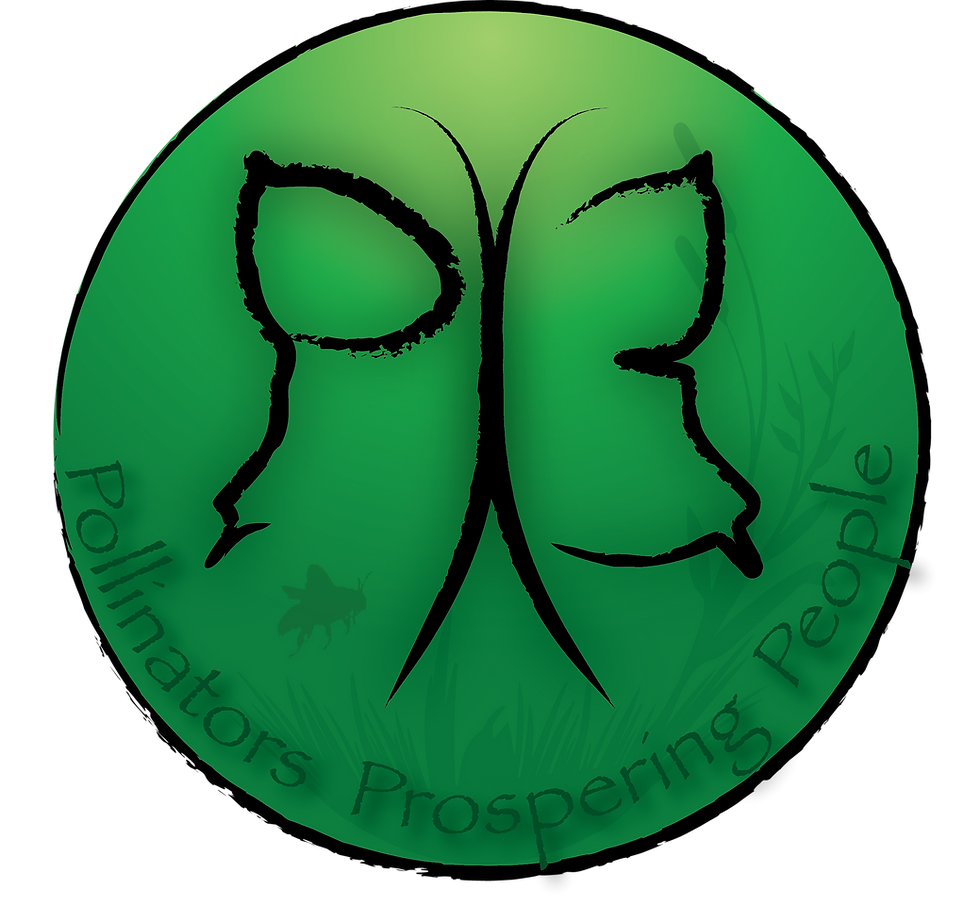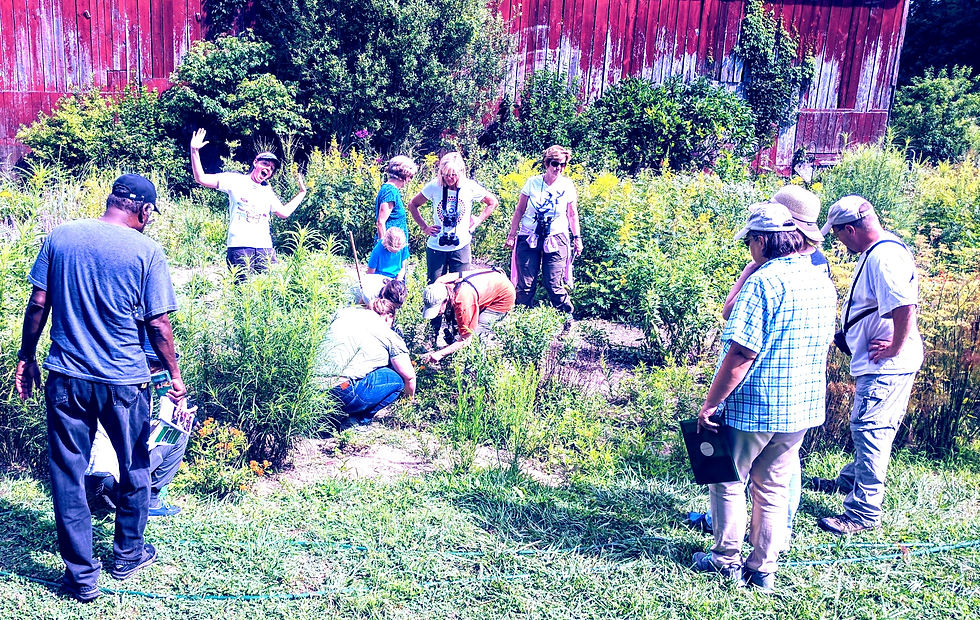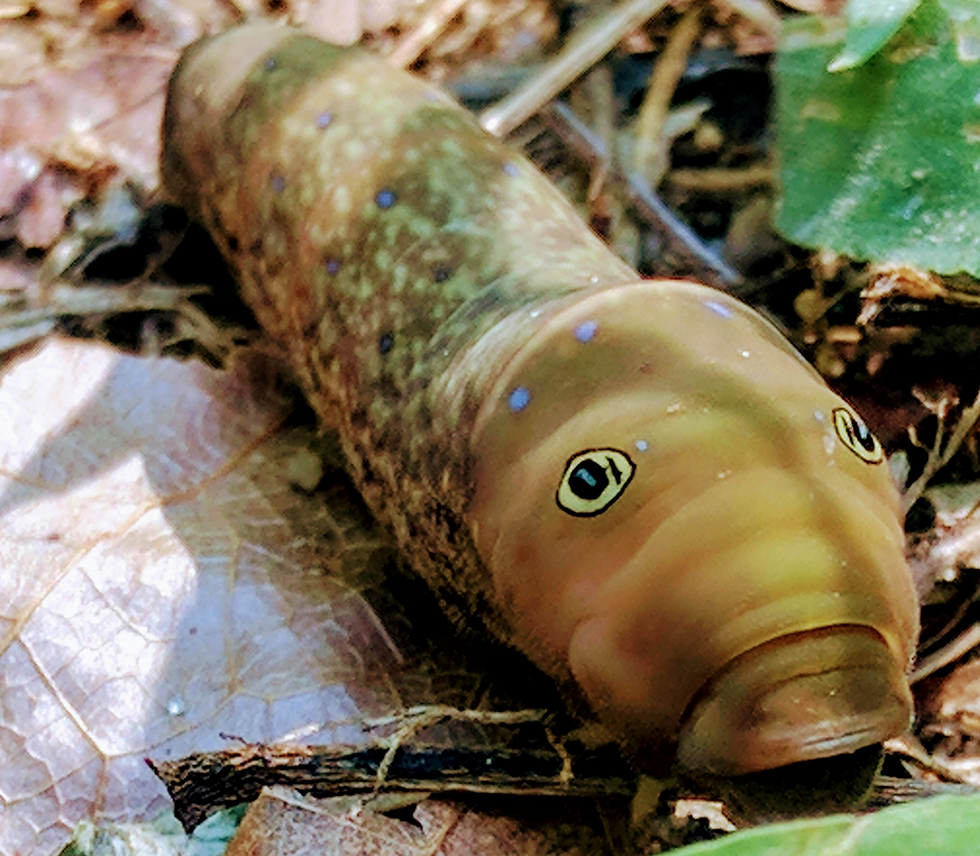Blue Drinks: Value of Pollinators Follow Up
- PX3 Team

- Jul 14, 2020
- 10 min read
Updated: Jul 14, 2020
PX3-Pollinators Prospering People’s mission is to provide services that proliferate sustainable pollinator habitat. We have services that we are in the midst of transforming into a virtual experience where applicable. Virtual assessments is a service we have been providing with our national clients previous to these complicating times. After assessments our team can help you put together a pollinator space that meets your goals. We encourage our pollinator garden clients to join our workshop series to learn to use the space as an outdoor classroom that will empower them to join the movement through community involvement and citizen science. Let PX3 know what we can help you with and stay tuned for our virtual workshop series.

The questions below are from the Wyoming Chapter of Inland Ocean Coalition Blue Drinks meeting I spoke at about the Value of Pollinators. Please feel free to contact me directly if you have any other questions. Take the pollinator challenge if you are looking to prompt yourself to start a conversation. We look forward to helping pollinators be a regular part of your life.
mel@px3-pollinators.com
Address no need to buy expensive bee housing Consider that native bees are just that, and are not accustomed to fancy house wares. The ability to just follow some simple guidelines empowers you to establish your own bee housing that in some instances will last for years.
Experiment, have fun and don’t spend a dime. There are groups of solitary bees that make use of simple holes drilled into spare wood blocks, wooden posts, or logs. These ‘tunnel blocks’ can range from 1/8” drill bit to 5/16” and depths can range between 4-6” but closed ended. The larger the hole the larger the species most often. The other favored housing is to put reeds and other pithy stems is larger holes of any size bigger than say 2” in diameter and similar depths. Old hollow pipes, drainage tubes, cardboard tubes, leaky coolers; feel free to be creative. Consider the material and where it is placed. Though many species love to be in the sun think about how material hold heat when choosing one. These tubes or tunnels don’t have to be in sun all day but appreciate a good amount nestled in garden spaces up above the vegetation line or at least a couple feet off the ground.

Other solitary bee housing can be bare soil you simply dig up from one location and build a hill of in your space in an area that is sunny. The hill structure can be as small as several 3’ feet diameter at the base and 18” to 24” high. Mulch piles, rock piles, cavern underground, old hay bales with holes dug in can be the best housing to encourage a bumble bee queen to inhabit your space. It helps to add spent rodent bedding from a pet store if these holes were not previously rodent holes. Bumblebees have a keen sense of smell and do not appreciate that of humans but, oddly enough, do appreciate that of old rodent nest. You don’t want to spend money on a bumble hive box. PX3 loves to have a building component to each part of our workshop series. Bumblebee boxes are fun to build and who is to say if they are never successful but the caveat to that build is it not a guarantee and it won’t be for years. We wanted to find that magic design but although fun and inspiring we are not sure success could be a definitive word.
When to put bee housing out
You can’t go wrong to put housing out in early spring. March 21st can be considered the first day of spring. Of course, if you live in Wyoming you might be sure those housing structures are in a safe place to not be carried off to Oz as so often can happen. If you are in Texas consider space that gets some shade. Always try and organize structure such that a downpour will not wash your new friends away. Just consider your location and make adjustments for your local landscape.
4 season habitat ideas Pollinators always need 4 things: water, food, housing, and space/territory.... Often with butterflies their host plant is not a food source for them as adults. On the permaculture side of things you want to plan for all 4 seasons, With the above 4 things in mind for all changes you want to include overwintering habitats along with housing for breeding. This way these new friends have no reason to leave your lovely yard. Water should be in shallow pools, containers with rocks or vegetation used to allow for pollinators to get out. Butterflies will often be seen ‘puddling’ on wet ground or even dry when they ‘spit’ on it to moisten it. This behavior is often males to collect important nutrients and minerals required for his part of the reproductive material. At our house we fill the bee water like the dog’s water; every morning.

Food: Again host plants are different than food plants and your goals should be put in order of who you want around. PX3 loves to provide guidance and can even walk your space out with you virtually. See our landscape design services for more details on how to set this experience up. Plants should be in collections of five and in bright colors and that have bloom times ranging from February to December depending where you are. Housing: Above we have discussed some housing techniques but also make sure that wintering habitat for overwintering females is in place. Cutting stemmed flower plants down to about 18”, the openings are important to some species. Mulch piles are ideal, hay bales, thick grass tufts left at about 18” high. Remembering where these hibernation hideouts are will be important come spring when you are cleaning up. Everyone is super sleepy, so helpless, you don’t want to have hosted a beautiful bumble queen all winter only to end her season too quickly in early spring when you are doing prep work for the growing season. Space: This is just a detail of animals in general but your degree of hosting will be relative to the size of your space. Top pollinator organizations I answered this question quickly during the Blue Drinks. In reality there are so many people doing amazing work. I listed just a few of our favorites but I will make a longer list here for you to explore that can be more specific and equally amazing at what they are doing (in alpha):
Bee City Bumble Bee Conservation Trust Ducks Unlimited Extension (s) from all University systems Journey North Monarch Joint Venture Monarch Watch North American Butterfly Association NPS NRCS NRPA Local non-profits and nature centers Pheasants and Quail Forever Pollinator Partnership Right of Way for Habitats The Nature Conservancy The Xerces Society USDA USFS USFW USGS WWF How to keep wasps out of bee housing
Wasps that wish to occupy housing bought for solitary bees are also solitary. There is no hive mentality and there is a single female rearing her next generation. These wasp species tend to be, not only far less aggressive than social wasps, but are fabulous predatory beneficial insects. Placing several housing structures around your space will allow for both solitary bees and wasps in what is most often a harmonious neighbor interaction. These bees and wasps are so busy they hardly have time to worry about the neighbors. There are however a few differences in housing you might create. There are groups of solitary bees and wasps that make use of simple holes drilled into spare wood blocks, wooden posts, or logs. These ‘tunnel blocks’ can range from 1/8” drill bit to 5/16” and depths can range between 4-6” but closed ended. The larger the hole the larger the species most often. The other favored housing is to put reeds and other pithy stems is larger holes of any size bigger than say 2” in diameter and similar depths. Old hollow pipes, drainage tubes, cardboard tubes, leaky coolers; feel free to be creative. Consider the material and where it is placed. Though many species love to be in the sun think about how material hold heat when choosing one. These tubes or tunnels don’t have to be in sun all day but appreciate a good amount nestled in garden spaces up above the vegetation line or at least a couple feet off the ground.
The social wasps don’t have the perfect solution but there are some structures you can encourage habitation of in hopes that the eaves of your favored reading spot, family’s picnic table, bbq pits, or any other hidden, shaded, protected area are not chosen. Wasps are serious predators of plant consuming caterpillars, aphids, grasshoppers, grubs and other garden pests that loot your hard work before you and yours can enjoy the fruits of your labor. Building shelters for social wasps and stationing them in outer garden locations can offer a more preferred space for these more aggressive species. Designs should resemble an old birdhouse or can be an old bird house begging to be repurposed. It is best to keep these away from areas of mowing, edging or other vibration making power tools. This will spook them and that is when they tend to become most aggressive.
Making a heavy spray of citronella, thyme, or eucalyptus oils that you would begin spraying on the eaves that are most concerning early in the spring and continue will also help deter nesting in these areas. Remember that oils volatilize and repeating this even weekly may be valuable. Planting the plants on your decks will also help but likely not as well as direct spraying or wiping of oils on those areas. Diligent observation for new nest build can be watched for and removed when the inhabitants are absent.
How to talk to stakeholders, i.e HOAs
Stakeholder communication can be delicate and best handled with an objective partner present. An objective partner is likely a subject specific educated professional that has experience with difficult conversations that can become fractious. Biologists and Natural Resource Managers are often trained in this mediation and are happy to speak to your group. PX3 has several highly capable speakers at the ready to help you through this touchy subject.

Pesticide /Herbicide least harm
There comes a time that most humans feel there is no other solution than to utilize some type of herbicide/ pesticide. Having a two year old’s birthday can’t be easy at summers end with a wasp nest under the picnic table. Treating that never-ending shepherd’s purse, or poison ivy from the swing set.
My husband and I have embarked on owning our own property and building a house on it. There is shepherd’s purse everywhere the soil is disturbed. I pulled and bag mowed 10 contractor bags full of this stuff so I didn’t have to use a foliar spray. Often weeds are subjective, but have growing habits that define an invasive plant. Early bloomers, fast emergence, prolific seed dispersal, my nemesis the ‘dehiscent seed’ and what if they are allelopathic, dumping toxic chemicals into the soil like Canada thistle? I try to always consider the other ecosystem service this ‘weed’ might be serving. Vines tend to hold soil in place and on steep services are often the only thing holding the soil in place. Early blooming plants support pollinators and in the absence of the trees, I am used to, these ‘weeds’ are the only thing I see available.
Mosquitoes, flies, aphids, potato bugs, grubs, yellow jackets, social wasps can all pose a frustrating conundrum. The top three suggestions I make to people is do anything to not use a foliar/broad spectrum spray. Spot spraying judiciously is another thing I often mention and thirdly ALWAYS follow the instructions on the bottle, pay attention to wind speed and time of day. Other more time-consuming aspects is be an educated consumer. Read up on the chemicals and not just the active ingredient but the solvent (most often more dangerous). Remember that UNLESS stated otherwise, and really who is going to add this, BUT LD50 is most often a lethal dose of 50% at immediate contact; not ingestion, not the pollen being fed to bee babies, or smothering a swallowtail caterpillar.

The Maryland Pesticide Network and Maryland Pesticide Education Network is an amazing resource. They work hard to put out the latest findings and best use practices. I highly encourage you as a HOA member or a pesticide/herbicide/fungicide user to look into these resources and know what you are using. The resource at the bottom of the page also have an enormous list of impacts to read through.
Can beneficial insects be dangerous
Can beneficial insects be dangerous? This is a consumer education related question. The species of mantis, lady bugs, dragonflies, parasatoids, etc… can be beneficial and get rid of what you want but make sure you know at what cost. Know if you live somewhere these species can live through the winter. Nature has a way of finding a path to genetic success so just be wary of what you are ordering and where it is from and will it out-compete your native species that if hosted properly can out way the benefits of those outside beneficial insects. Also be careful what you consider dangerous. Cuckoo species, native parasatoid wasps that lay eggs on your tomato horn worms but other caterpillars too…..these have their place and are native most times.
As far as being dangerous there are few known Hymenoptera to cause severe allergic reactions, the honeybee and some hornets, fire ants are those that are common in the states. It does not mean they can’t hurt, it just means that venoms are different and expensive to produce. If you are not a social insect with specific individuals that play the role of being the ultimate sacrifice it is very expensive to sting a non-prey item and even then it is considerable. There are small amounts of bees capable of stinging, very few spiders with mouth parts big enough and YES there are many species of Hymenoptera that will bite you before they sting; just as there are many venomous snakes that will not bite with venom first, even if they do have it. Caterpillars are a common sting felt in a garden that bees get the blame for. Caterpillars too have to defend themselves and they are just enjoying a meal when you brush up against them.

Benefit of native plants to native pollinators
Broadly pollinators come in two feeding groups: Specialists & Generalists. This again does not include host plants which can actually almost be defined the same way. Many butterflies and moths stick to a family of plants as host plants, as an example. Native plants often have a very specific pollinator that is picky, like a child who will only eat macaroni and cheese. Those co-evolved species need one another in good numbers for genetic success. Often generalists that are not native (enter the honeybee) can out-compete the specialists. Pollen and nectar thieves are real, and if a plant is able to release toxins to rid themselves of the would-be burglar, then we need to consider what that means when choosing who to be hospitable to.
Favored Resources
Attracting Native Pollinators publication of The Xerces Society
The Bees in Your Backyard by J.S. Wilson & O.M. Carril
The Humane Gardener by Nancy Lawson
Promoting Pollinators On Your Place a Wyoming Guide by University of Wyoming Extension
Farming for Bees publication of The Xerces Society
Befriending Bumble Bees: A Practical Guide to Raising Local Bumble Bees by E. Evans, I. Burris, M. Spivak
Farming with Beneficial Insects publication of The Xerces Society
Feed the Bees publication of The Xerces Society
Bumble Bees of North America Identification by P. Williams, R. Thorp, Leif Richardson, S. Colla
iNaturalist
Gardens with Wings
USDA plant database
Ladybird Johnson Wildflower Center Plant Database
.png)






Commenti